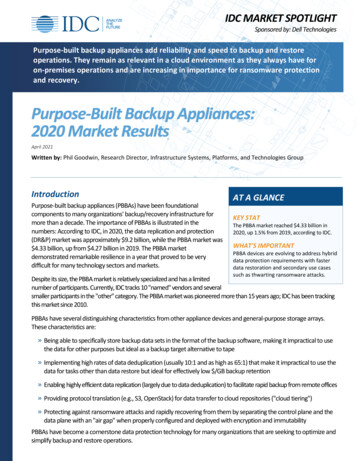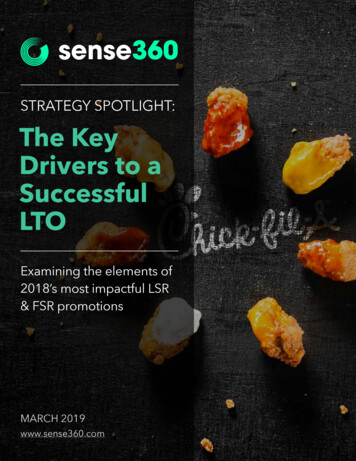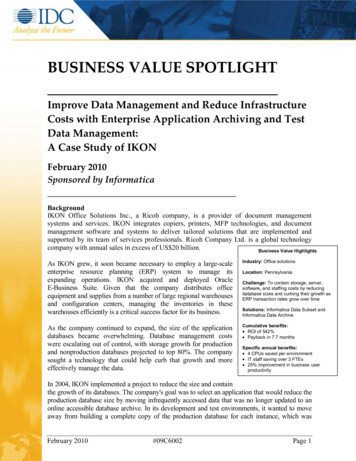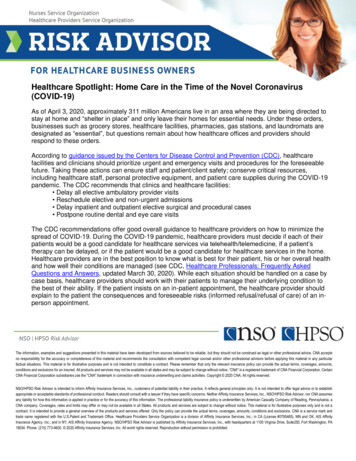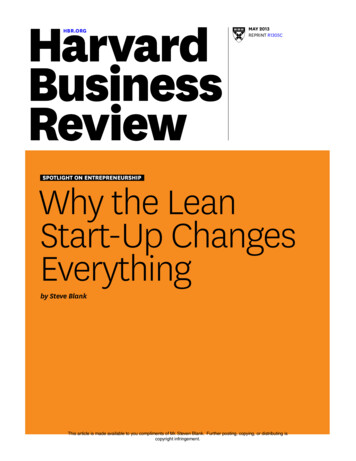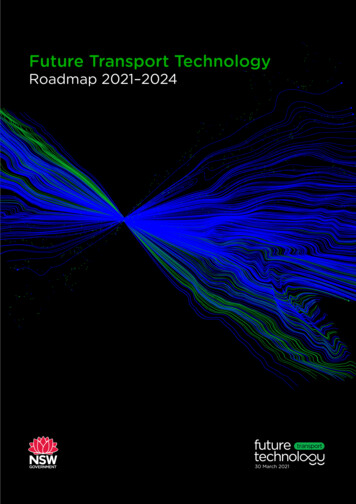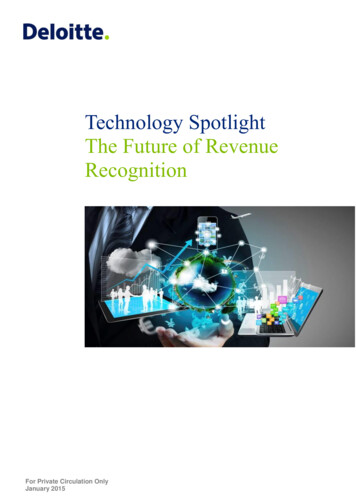
Transcription
Technology SpotlightThe Future of RevenueRecognitionFor Private Circulation OnlyJanuary 2015
ContentsExecutive summary3Background4Key Accounting Issues5Other Accounting Issues13Considerations and Challenges for Technology Entities18Thinking Ahead192
Executive summary On May 28, 2014, the Financial Accounting Standards Board (FASB) and the International AccountingStandards Board (IASB) issued their final standard on revenue from contracts with customers. Thestandard, issued as Accounting Standards Update 2014-09 (and codified as Topic 606 in the FASBAccounting Standards Codification) by the FASB and as IFRS 15 by the IASB, outlines a singlecomprehensive model for entities to use in accounting for revenue arising from contracts with customersand supersedes most current revenue recognition standard (including industry-specific guidance in U.S.GAAP1). The Institute of Chartered Accountants of India (ICAI) has recently issued an Exposure Draft (ED) of theproposed Indian Accounting Standard (Ind AS) 115, Revenue from Contracts with Customers i.e. theproposed IFRS Converged accounting standard for Indian entities, which is similar to IFRS 15. The new revenue recognition standard requires that goods or services in a contract that are “highlydependent on, or highly interrelated with, other goods or services promised in the contract” or that“significantly modify or customise” each other are not considered distinct performance obligations.Applying these criteria may require significant judgment. When contract consideration is variable, revenue should be recognised only to the extent that it isprobable that a significant revenue reversal will not occur. In arrangements involving sales- or usagebased licenses of intellectual property, revenue is recognised only when it is determinable (i.e., when thesale or usage has occurred). Entities that license software to customers may need to determine whether they provide a “right to usethe entity’s intellectual property as it exists at a point in time” (a “static” license for which control istransferred at a point in time) or “access to the entity’sintellectual property as it exists throughout the licenseperiod” (a “dynamic” license for which control istransferred over time).The new revenue standardsupersedes most currentrevenue recognitionguidance, includingindustry-specific guidance. Since the new standard requires significantly moreextensive disclosures, technology entities may need tomodify their systems and processes to gatherinformation about contracts with customers that is nototherwise readily available. This Technology Spotlight discusses the new revenue model and highlights key accounting issues andpotential challenges for technology entities.1The U.S. Securities and Exchange Commission (SEC) has indicated that it plans to review and update the revenue recognition guidance in SECStaff Accounting Bulletin (SAB) Topic 13, “Revenue Recognition,” when the new standard is issued. The extent to which the new standard will affecta public entity will depend on whether the SEC removes or amends the guidance in SAB Topic 13 to be consistent with the new revenue standard.Technology Spotlight – The Future of Revenue Recognition3
BackgroundThe goals of the new revenue recognition standard are (1) streamlining, and removing inconsistencies from,revenue recognition requirements; (2) providing “a more robust framework for addressing revenue issues”;(3) making revenue recognition practices more comparable; and (4) increasing the usefulness of disclosures.The new revenue recognition standards states that the core principle for revenue recognition is that an “entityshall recognise revenue to depict the transfer of promised goods or services to customers in an amount thatreflects the consideration to which the entity expects to be entitled in exchange for those goods or services.”The new standard indicates that an entity should perform the following five steps in recognising revenue: “Identify the contract(s) with a customer” (step 1); “Identify the performance obligations in the contract”(step 2); “Determine the transaction price” (step 3); “Allocate the transaction price to the performanceobligations in the contract” (step 4); and “Recognise revenue when (or as) the entity satisfiesa performance obligation” (step 5)As a result of the newstandard, entities will need tocomprehensively reassesstheir current revenueaccounting and determinewhether changes arenecessary.Thinking It ThroughAs a result of the new standard, entities will need to comprehensively reassess their currentrevenue accounting and determine whether changes are necessary. In addition, the new standardrequires significantly expanded disclosures about revenue recognition, including both quantitativeand qualitative information about (1) the amount, timing, and uncertainty of revenue (and relatedcash flows) from contracts with customers; (2) the judgment, and changes in judgment, used inapplying the revenue model; and (3) the assets recognised from costs to obtain or fulfil a contractwith a customer.Technology Spotlight – The Future of Revenue Recognition4
Key Accounting IssuesThis technology spotlight discusses the new revenue model and highlights key accounting issues andpotential challenges for technology entities.Identifying the Contract with the Customer (Step 1)A contract can be written, verbal, or implied; however, the new standard applies to a contract only if all of thefollowing criteria are met: “The parties to the contract have approved the contract (in writing, orally, or in accordance with othercustomary business practices) and are committed to perform their respective obligations.” “The entity can identify each party’s rights regarding the goods or services to be transferred.” “The entity can identify the payment terms for the goods or services to be transferred.” “The contract has commercial substance (that is, the risk, timing, or amount of the entity’s future cashflows is expected to change as a result of the contract).” “It is probable that the entity will collect the consideration to which it will be entitled in exchange for thegoods or services that will be transferred to the customer.” 2If a contract does not meet these criteria at contract inception, an entity must continue to reassess the criteriato determine whether they are subsequently met.CollectabilityThe new standard establishes a collectability threshold underwhich an entity must determine whether “[i]t is probable that theentity will collect the consideration to which it will be entitled.” Ifthe threshold is not met, the entity is precluded from applying theremaining steps in the new standard and recognising revenueuntil it is probable3 that the consideration will be collected. Anyamounts received before collectability is considered probablewould be recorded as revenue only if the consideration receivedis non-refundable and either (1) all performance obligations in thecontract have been satisfied and substantially all of the promisedconsideration has been received or (2) the contract has beenterminated or cancelled. If those conditions are not met, anyconsideration received would be recognised as a liability.The new standardestablishes a collectabilitythreshold under which anentity must determinewhether “[i]t is probable thatthe entity will collect theconsideration to which itwill be entitled”.For contracts that have a variable sales price (including price concessions), entities would first estimate theconsideration due under the contract (see Determining the Transaction Price (Step 3) below) and wouldthen apply the collectability threshold to the estimated transaction price.2In assessing whether it is probable that the entity will collect the consideration, an entity would consider only the customer’s ability and intention topay that amount of consideration when it is due. The amount of consideration evaluated may be less than the price stated in the contract if theconsideration is variable because the entity may offer price concessions (see step 3 on determining the transaction price).3Under U.S. GAAP, “probable” refers to a “future event or events [that] are likely to occur.” This threshold is considered higher than “probable” asused in IFRSs and Ind AS, under which the term means “more likely than not.”Technology Spotlight – The Future of Revenue Recognition5
Thinking It ThroughTechnology entities often offer extended payment terms (see Significant Financing Componentbelow for additional information). In certain cases (e.g., when the contract is with a financiallystressed customer), entities may be unable to assert that the collectability of the total estimatedtransaction price is probable. In such situations, the contract would not be accounted for under thenew standard’s remaining steps until collectability is probable. As mentioned above, any amountsthat are received before the probability threshold is met would usually be recorded as a liabilityunless the amount is non-refundable and either (1) all performance obligations under the contracthave been satisfied and substantially all of the consideration has been received or (2) the contracthas been cancelled, in which case the amount would be recognised as revenue.If the probability threshold is subsequently met, all remaining revenue related to satisfiedperformance obligations, including revenue that had been deferred, would be recognised. Thistreatment may differ from that of current GAAP for the technology entities.Contract CombinationAlthough entities would most likely apply the new standard toa single contract, in certain circumstances they may berequired to combine a group of contracts and evaluate themas if they were a single contract. Under the new standard, anentity must combine contracts entered into at or near thesame time with the same customer (or related parties of thecustomer) if one or more of the following criteria are met: “The contracts are negotiated as a package with asingle commercial objective.” “The amount of consideration to be paid in one contractdepends on the price or performance of the othercontract.” “The goods or services promised in the contracts (orsome goods or services promised in each of thecontracts) are a single performance obligation [asdefined].”Although entities wouldmost likely apply the newstandard to a singlecontract, in certaincircumstances they may berequired to combine agroup of contracts andevaluate them as if theywere a single contract.Thinking It ThroughSince technology entities commonly enter into multiple agreements with the same customerwithin a short period, they need to consider whether certain contracts should be combined forrevenue recognition purposes. Although the contract combination requirements mentionedabove may be similar to certain aspects of existing guidance, entities may need to re-evaluatetheir conclusions under the new standard to determine whether changes in contractcombinations may be necessary.Contract ModificationsThe new standard also provides guidance on accounting for “approved” modifications to contracts withcustomers. The approval of a contract modification can be in writing, by oral agreement, or implied bycustomary business practices, and a contract modification is considered approved when it creates new orchanges existing enforceable rights or obligations. A contract modification must be accounted for as aseparate contract when (1) it results in a change in contract scope because of additional promised “distinct”goods or services (see Identifying the Performance Obligations (Step 2) below) and (2) the additionalconsideration reflects the entity’s stand-alone selling price of those additional promised goods or services(including any appropriate adjustments to reflect the circumstances of the contract). If an entity determinesthat the modification is not a separate contract, the entity would, depending on the specific facts andcircumstances of the modified contract, apply one of the following methods:Technology Spotlight – The Future of Revenue Recognition6
Treatment as a new contract (prospective method) — If the remaining goods or services are distinct fromthe goods or services transferred on or before the date of the contract modification, the remainingtransaction price4 and any additional consideration promised as a result of the modification are allocatedto the remaining performance obligations in the modified contract. Cumulative catch-up adjustment (retrospective method) — If the remaining goods or services are notdistinct and are part of a single performance obligation that is partially satisfied as of the date of thecontract modification, the performance obligation’s measure of progress toward completion is updated,which may result in a cumulative catch-up of revenue. A combination of these two methods (if both of the above conditions exist).Thinking It ThroughTechnology entities often enter into agreements that may amend, terminate, or otherwise changethe provisions of the master or original agreement (e.g., side agreements). These entities mayneed to use judgment in determining whether such agreements represent approved modificationsand whether each modification should be accounted for as a separate contract or dealt with underthe prospective or retrospective method outlined above. The accounting for such modificationsunder the new standard may differ from that under current GAAP.Identifying the Performance Obligations (Step 2)The new standard provides guidance on evaluating the promised “goods or services” 5 in a contract todetermine each performance obligation (i.e., the unit of account). A performance obligation is each promiseto transfer either of the following to a customer: “A good or service (or a bundle of goods or services) that is distinct.” “A series of distinct goods or services that aresubstantially the same and that have the same patternof transfer to the customer.”6A promised good or service is distinct (and therefore aperformance obligation) if both of the following criteria aremet:The new standard providesguidance on evaluating thepromised “goods orservices” in a contract todetermine each performanceobligation (i.e., the unit ofaccount). Capable of being distinct — “The customer can benefitfrom the good or service either on its own or togetherwith other resources that are readily available to thecustomer.” Distinct within the context of the contract — “The entity’s promise to transfer the good or service to thecustomer is separately identifiable from other promises in the contract.” The new standard provides thefollowing indicators for evaluating whether a promised good or service is separable from other promisesin a contract:4–“The entity does not provide a significant service of integrating the good or service with other goodsor services promised in the contract . . . . In other words, the entity is not using the good or serviceas an input to produce or deliver the combined output specified by the customer.”–“The good or service does not significantly modify or customise another good or service promised inthe contract.”Under the revenue model, the transaction price available for allocation would include the “consideration promised by the customer (includingamounts already received from the customer) that was included in the estimate of the transaction price and that had not been recognised asrevenue.”5Although the new standard does not define goods or services, it includes several examples, such as goods produced (purchased) for sale (resale),granting a license, and performing contractually agreed-upon tasks.6A series of distinct goods or services has the same pattern of transfer if both of the following criteria are met: (1) each distinct good or service in theseries would meet the criteria for recognition over time and (2) the same measure of progress would be used to depict performance in the contract.Technology Spotlight – The Future of Revenue Recognition7
–“The good or service is not highly dependent on, or highly interrelated with, other goods or servicespromised in the contract. For example, a customer could decide to not purchase the good or servicewithout significantly affecting the other promised goods or services.”Thinking It ThroughThe requirement that the promise to transfer a good or service be “separately identifiable fromother promises in the contract” is a new concept under which entities must further evaluate a goodor service for separability. Entities may need to use significant judgment when determining whetherthe goods or services in a contract are “highly dependent on, or highly interrelated with, othergoods or services promised in the contract” or whether they “significantly modify or customize”each other. In such circumstances, entities may need to account for a bundle of goods or services,which may qualify for separate accounting under current GAAP, as a single performance obligation(unit of account).Example 11 in the new revenue standard under U.S. GAAP and IFRS presents two cases thatillustrate how technology entities would determine whether goods or services in a softwarearrangement are distinct. Each case depicts a typical software arrangement involving a license, aninstallation service, software updates, and technical support. In Case A, the installation servicedoes not significantly modify or customize the software; in Case B, however, the installation servicesignificantly modifies and customizes it. The new revenue standard concludes that the license andinstallation service would be considered distinct from each other in Case A but not in Case B.Entities with software arrangements similar to the one in Case A should refer to that illustration andreasonably reach the same conclusion.The assessment of whether goods or services in a contract are highly dependent on, or highlyinterrelated with, one another may be particularly challenging for entities with technologyarrangements. For example, software-as-a-service (SaaS) arrangements are often bundledtogether with additional products or services, such as implementation or consulting services, in asingle arrangement (see SaaS Arrangements below for more information). Entities may find itdifficult to determine whether the hosted software and other products or services offered areseparately identifiable, depending on the nature of each item and how the items interact. However,if certain products or services offered under an arrangement have the same pattern of transfer,entities could effectively measure and recognize them as a single performance obligation under thenew revenue standard. This guidance may simplify the identification of all distinct performanceobligations under certain contracts.The assessment ofwhether goods orservices in a contractare highly dependenton, or highlyinterrelated with, oneanother may beparticularlychallenging fortechnology entities.Technology Spotlight – The Future of Revenue Recognition8
Renewal OptionsUnder the new standard, an option given to a customer toacquire additional goods or services represents aperformance obligation if it provides a “material right” to thecustomer that it otherwise would not have received withoutentering into the contract. If an option is deemed aperformance obligation, an entity must allocate a portion ofthe transaction price to the option and recognise revenuewhen control of the goods or services underlying the optionis transferred to the customer or when the option expires.Under the new standard, ifthe renewal option providesthe customer with a materialright that it would not havereceived had it not enteredinto the contract, the optionshould be treated as aseparate performanceobligation.Thinking It ThroughContracts in the technology industry often offer customers the option to renew their contract withthe entity at potentially favourable rates once the initial contract term expires or without incurringany addit
Entities that license software to customers may need to determine whether they provide a “right to use the entity’s intellectual property as it exists at a point in time” (a “static” license for which control is transferred at a

